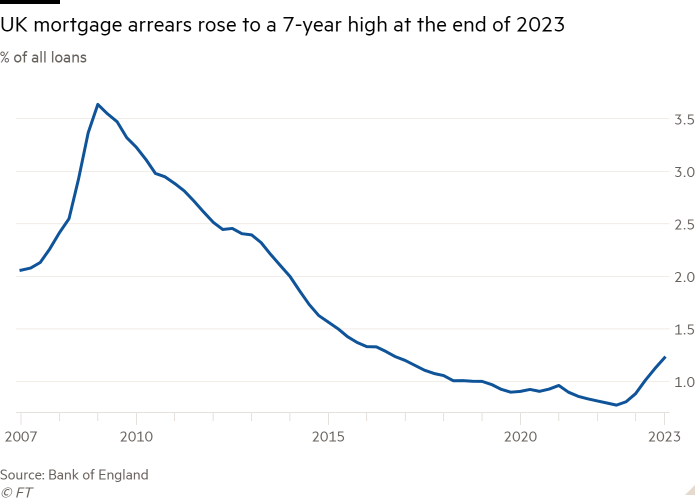Unlock the Editor’s Digest for free
Roula Khalaf, Editor of the FT, selects her favourite stories in this weekly newsletter.
UK mortgages in arrears hit a seven-year high in the final quarter of 2023, according to official data that underlines the impact of high borrowing costs on households.
The proportion of total loan balances with arrears, relative to outstanding mortgage balances, rose to 1.23 per cent in the three months to December 31 from 1.12 per cent in the third quarter, the Bank of England said on Tuesday.
The figures marked a reversal of a long-term decline in overdue payments and the highest share since the final quarter of 2016, when it stood at 1.24 per cent.
The trend in rising home loan arrears follows a sharp increase in mortgage costs over the past three years, as the BoE lifted interest rates to a 16-year high of 5.25 per cent in a bid to tame inflation. Nevertheless, the share of mortgages in arrears remains well below a peak of 3.64 per cent in the first quarter of 2009 during the global financial crisis.
Karen Noye, mortgage expert at wealth management company Quilter, said: “The large increase in mortgage rates seen over the last couple of years is really starting to bite for some borrowers and this is unfortunately causing them to fall into arrears as they simply can’t afford to keep up with their increased payments.”

Financial markets expect the BoE to start cutting interest rates from this summer, taking the benchmark rate to 4.5 per cent by the end of the year.
The re-pricing of interest rate expectations has caused lenders to offer cheaper deals, but households continue to face higher mortgage payments as their fixed contracts expire.
The average two-year mortgage with 60 per cent loan to value was 4.62 per cent in February, according to the central bank. That is below a peak of 6.22 per cent last July but well above the 1.29 per cent average in 2020 and 2021, when interest rates stood at 0.1 per cent.
Simon Gammon, managing partner at broker Knight Frank Finance, said: “At 1.23 per cent, the proportion of loan balances in arrears is still very low, but the pace at which it is rising will be a source of concern for policymakers.”
Home loan arrears are lower than during the 2008-09 financial crisis in part because of a resilient labour market and improved mortgage regulations.
In research published last month, the BoE said “the vast majority of borrowers” who came to the end of fixed deals in 2023 were offered rates below those they had been tested by when agreeing terms.
The BoE data on Tuesday also showed that the share of gross mortgage advances for buy-to-let purposes fell by 4.9 percentage points year-on-year in the final quarter to 7 per cent, the lowest since 2010.
Noye said landlords had been “hit with numerous changes to the buy-to-let tax landscape in recent years, making it a less attractive option”, and that “the changes to the holiday let rules at the Budget may also make things even worse”.











